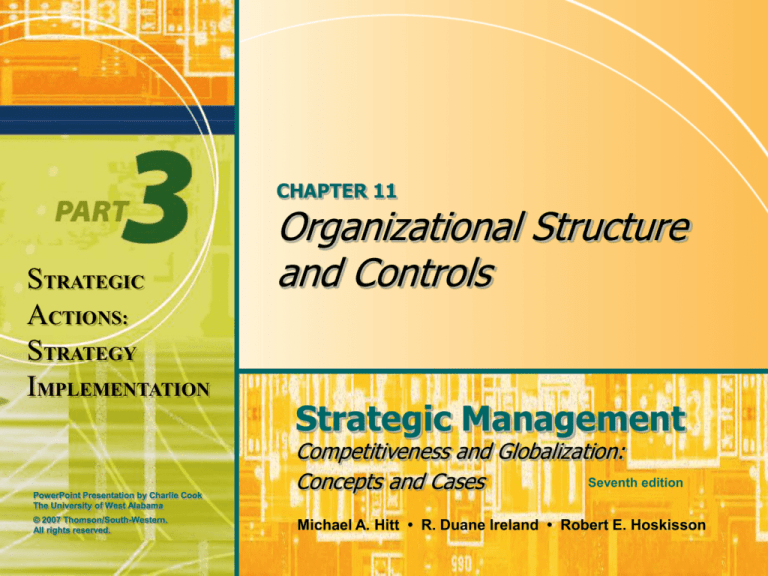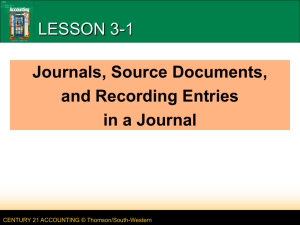
CHAPTER 11
STRATEGIC
ACTIONS:
STRATEGY
IMPLEMENTATION
PowerPoint Presentation by Charlie Cook
The University of West Alabama
© 2007 Thomson/South-Western.
All rights reserved.
Organizational Structure
and Controls
Strategic Management
Competitiveness and Globalization:
Seventh edition
Concepts and Cases
Michael A. Hitt • R. Duane Ireland • Robert E. Hoskisson
Organizational Structure and Controls
• Organizational structure specifies:
The firm’s formal reporting relationships, procedures,
controls, and authority and decision-making
processes
The work to be done and how to do it, given the firm’s
strategy or strategies
• It is critical to match organizational structure to
the firm’s strategy.
© 2007 Thomson/South-Western. All rights reserved.
11–2
Organizational Structure
• Effective structures provide:
Stability
Flexibility
• Structural stability provides:
The capacity required to consistently and predictably
manage daily work routines
• Structural flexibility provides for:
The opportunity to explore competitive possibilities
The allocation of resources to activities that shape
needed competitive advantages
© 2007 Thomson/South-Western. All rights reserved.
11–3
Organizational Controls
• Purposes of Organizational Controls:
Guide the use of strategy.
Indicate how to compare actual results with expected
results.
Suggest corrective actions to take when the
difference between actual and expected results is
unacceptable.
• Two Types of Organizational Controls
Strategic controls
Financial controls
© 2007 Thomson/South-Western. All rights reserved.
11–4
Organizational Controls
Strategic
Controls
Organizational
Controls
Financial
Controls
• Strategic Controls: Subjective criteria
Are concerned with examining the fit between:
• What the firm might do (opportunities in its external
environment).
• What the firm can do (competitive advantages).
Evaluate the degree to which the firm focuses on the
requirements to implement its strategy.
© 2007 Thomson/South-Western. All rights reserved.
11–5
Organizational Controls
Strategic
Controls
Organizational
Controls
Financial
Controls
• Financial Controls: Objective criteria
Accounting-based measures include:
• Return on investment
• Return on assets
Market-based measures include:
• Economic Value Added (EVA)
© 2007 Thomson/South-Western. All rights reserved.
11–6
Matching Control to Strategy
• Relative use of controls varies by type of
strategy:
Large diversified firms using a cost leadership
strategy emphasize financial controls.
Companies and business units using a differentiation
strategy emphasize strategic controls.
© 2007 Thomson/South-Western. All rights reserved.
11–7
Relationships between Strategy and Structure
• Strategy and structure have a reciprocal
relationship:
Structure flows from or follows the selection of the
firm’s strategy but …
Once in place, structure can influence current
strategic actions as well as choices about future
strategies.
© 2007 Thomson/South-Western. All rights reserved.
11–8
Evolutionary Patterns of Structure and
Organizational Structure
• Firms grow in predictable patterns:
First by volume
Then by geography
Then integration (vertical, horizontal)
And finally through product/business diversification
• A firm’s growth patterns determine its structural
form.
© 2007 Thomson/South-Western. All rights reserved.
11–9
Evolutionary Patterns of Structure and
Organizational Structure (cont’d)
• All organizations require some form of
organizational structure to implement and
manage their strategies
• Firms frequently alter their structure as they grow
in size and complexity
• Three basic structure types:
Simple structure
Functional structure
Multidivisional structure (M-form)
© 2007 Thomson/South-Western. All rights reserved.
11–10
Strategy
and
Structure
Growth
Pattern
Simple Structure
Efficient implementation
of formulated strategy
Sales Growth
Coordination and Control Problems
Functional Structure
Efficient implementation
of formulated strategy
Sales Growth
Coordination and Control Problems
Multidivisional Structure
© 2007 Thomson/South-Western. All rights reserved.
11–11
FIGURE 11.1
Strategy and
Structure Growth
Pattern
© 2007 Thomson/South-Western. All rights reserved.
11–12
Strategy and Structure: Simple Structure
• Owner-manager
Makes all major decisions directly.
Monitors all activities.
• Staff
Serves as an extension of the manager’s supervisor
authority.
• Matched with focus strategies and business-level
strategies
Commonly complete by offering a single product line
in a single geographic market.
© 2007 Thomson/South-Western. All rights reserved.
11–13
Simple Structure (cont’d)
• Growth creates:
Complexity
Managerial and structural challenges
• Owner-managers
Commonly lack organizational skills and experience.
Become ineffective in managing the specialized and
complex tasks involved with multiple organizational
functions.
© 2007 Thomson/South-Western. All rights reserved.
11–14
Strategy and Structure: Functional Structure
• Chief Executive Officer (CEO)
Limited corporate staff
• Functional line managers in dominant
organizational areas of:
Production
Marketing Engineering
Accounting
R&DHuman resources
• Supports use of business-level strategies and
some corporate-level strategies
Single or dominant business with low levels of
diversification
© 2007 Thomson/South-Western. All rights reserved.
11–15
Functional Structure (cont’d)
• Differences in orientation among organizational
functions can:
Impede communication and coordination.
Increase the need for CEO to integrate decisions and
actions of business functions.
Facilitate career paths and professional development
in specialized functional areas.
Cause functional-area managers to focus on local
versus overall company strategic issues.
© 2007 Thomson/South-Western. All rights reserved.
11–16
Strategy and Structure: Multidivisional
Structure
• Strategic Control
Operating divisions function as separate businesses
or profit centers
• Top corporate officer delegates responsibilities to
division managers
For day-to-day operations
For business-unit strategy
• Appropriate as firm grows through diversification
© 2007 Thomson/South-Western. All rights reserved.
11–17
Multidivisional Structure (cont’d)
• Three Major Benefits
Corporate officers are able to more accurately monitor
the performance of each business, which simplifies
the problem of control.
Facilitates comparisons between divisions, which
improves the resource allocation process.
Stimulates managers of poorly performing divisions to
look for ways of improving performance.
© 2007 Thomson/South-Western. All rights reserved.
11–18
Matching Strategy and Functional Structure
• Different forms of the functional organizational
structure are matched to:
Cost leadership strategy
Differentiation strategy
Integrated cost leadership/differentiation strategy
• Differences in these forms are seen in three
important structural characteristics:
Specialization (number and types of jobs)
Centralization (decision-making authority)
Formalization (formal rules and work procedures)
© 2007 Thomson/South-Western. All rights reserved.
11–19
FIGURE 11.2
Functional Structure for Implementation
of a Cost Leadership Strategy
Notes:
• Operations is the main function
• Process engineering is emphasized
rather than new product R&D
• Relatively large centralized staff
coordinates functions
• Formalized procedures allow for
emergence of a low-cost culture
• Overall structure is mechanical; job
roles are highly structured
© 2007 Thomson/South-Western. All rights reserved.
11–20
Using the Functional Structure to Implement
a Cost Leadership Strategy
• Operations is the main function.
Process engineering is emphasized over research
and development.
Large centralized staff oversees activities.
Formalized procedures guide actions.
Structure is mechanical.
Job roles are highly structured.
© 2007 Thomson/South-Western. All rights reserved.
11–21
FIGURE
11.3
Functional Structure for Implementation
of a Differentiation Strategy
Notes:• Marketing is the main function for keeping track of new product ideas
• New product R&D is emphasized
• Most functions are decentralized, but R&D and marketing may have centralized staffs that work closely with each other
• Formalization is limited so that new product ideas can emerge easily and change is more readily accomplished
• Overall structure is organic; job roles are less structured
© 2007 Thomson/South-Western. All rights reserved.
11–22
Using the Functional Structure to Implement
a Differentiation Strategy
• Marketing is the main function for tracking new
product ideas.
New product R&D is emphasized.
Most functions are decentralized.
Formalization is limited to foster change and promote
new ideas.
Overall structure is organic.
Job roles are less structured.
© 2007 Thomson/South-Western. All rights reserved.
11–23
Using the Functional Structure to Implement
the Integrated Cost Leadership/
Differentiation Strategy
• Selling products that create customer value due
to:
Their relatively low product cost through an emphasis
on production and process engineering, with
infrequent product changes.
Reasonable sources of differentiation based on newproduct R&D are emphasized while production and
process engineering are not.
• Used frequently in global economy
© 2007 Thomson/South-Western. All rights reserved.
11–24
Implementing an Integrated Cost
Leadership/Differentiation Strategy (cont’d)
• The integrated form of the functional structure
must have:
Decision-making patterns that are partially centralized
and partially decentralized.
Semi-specialized jobs.
Rules and procedures that allow both formal and
informal job behaviors.
© 2007 Thomson/South-Western. All rights reserved.
11–25
Corporate-Level Strategies and the
Multidivisional Structure
• A firm’s continuing success that leads to:
Product diversification, or
Market diversification, or
Both product and market diversification.
• Increasing diversification creates control
problems that the functional structure can’t
handle.
Information processing, coordination
Control
© 2007 Thomson/South-Western. All rights reserved.
11–26
Corporate-Level Strategies and the
Multidivisional Structure (cont’d)
• Diversification strategy requires firm to change
from functional structure to a multidivisional
structure.
© 2007 Thomson/South-Western. All rights reserved.
11–27







